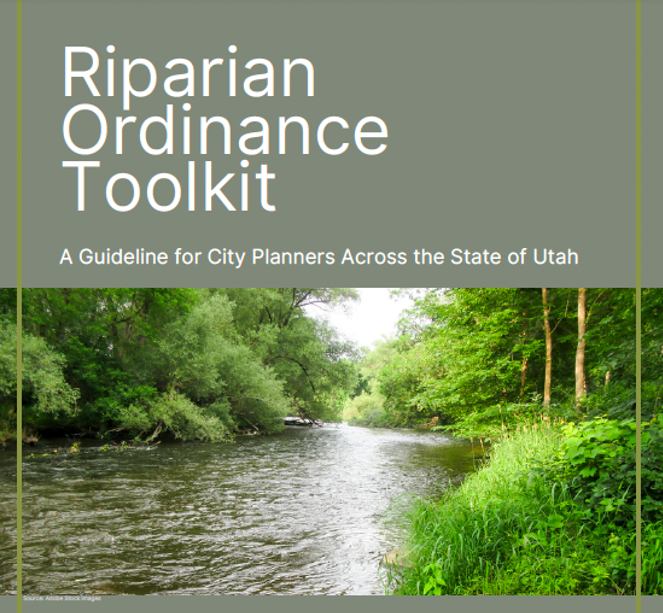IntroductionWeather and climate activity over the past several years has brought new focus to riparian corridors in Utah. We have witnessed extreme drought and flooding. The Jordan River Watershed, which encompasses the most urbanized region of Utah, is no stranger to this. Many communities around the Jordan River are looking for guidance with riparian corridors, especially smaller communities with limited staff and resources. This work has often been done with a patchwork of approaches, and without cooperation and coordination that is often needed for healthy systems that cross jurisdictional boundaries.
Over the past several years, federal, state and local legislative bodies have taken many important steps to address water conservation, water resources, water quality, and the declining levels of Great Salt Lake and the Colorado River. As the efforts to restore in-stream flows and return more water to our lakes and rivers, we know that riparian corridors must be healthy and functioning in order to be effective during times of both overabundance and scarcity of water. The Jordan River and its watershed will be a great beneficiary of these efforts.
Riparian Corridor Working Group
Earlier this year, Representative Gay Lynn Bennion (District 41 – Salt Lake County), with guidance from the Utah Water Task Force, asked the Jordan River Commission to help organize a working group to identify case studies of riparian corridor planning, regulations and effective management in Utah and the West. This working group identified ways to encourage and support healthy riparian corridors in both rural and urban areas, which are often closely connected within these systems.
The Riparian Corridor Working Group has identified three main goals that they want to achieve. They are as follows:
Create a central repository of resources that are easily accessible
They identified the Governor's Office of the Property Rights Ombudsman as a good option. Recently appointed Ombudsman, Rob Terry has agreed to host the information on their website. The Riparian Ordinance Toolkit and other resources will be available in the future.
Increase engagement and education on riparian corridors
They had an opportunity to present at the Wasatch Front Regional Council meeting in September and they will present another workshop at the upcoming Salt Lake County Watershed Symposium on November 16.
Draft Legislation for the State
A working draft of the Riparian Corridor Amendments has been released for the upcoming 2024 General Session. The amendment is to help direct cities and counties to adopt riparian corridor considerations into their general plans within the next 5 years. Without a coordinated statewide effort, protection of riparian zones will be a patchwork effort that doesn’t effectively protect our waterways.
The Riparian Ordinance Toolkit
Under the direction of Dr. Jennifer Follstad Shah, a group of students at the University of Utah created a Riparian Ordinance Toolkit in the spring of 2023 to help city planners in Cottonwood Heights who were developing a riparian ordinance. They collected information from other cities who have adopted Riparian Ordinances or have utilized other planning and development tools for protecting riparian zones. The intent being that it would be helpful for others in the future who are undergoing the same process.
The purpose of a Riparian Protection Ordinance is to protect and enhance riparian areas to promote public health, safety, and welfare. The standards within a Riparian Protection Ordinance typically aim to provide:
An ecologically sound transition between riparian habitat and developed areas,the continuation of natural functions & connectivity,protection of aesthetic values & private property rights
The Toolkit includes:List of Elements of a typical Riparian OrdinanceContact Information for Agencies with Regulatory AuthorityExamples of existing ordinances and regulations
View the Toolkit HERE
Lehi and Salt Lake City developed and adopted riparian zoning ordinances many years ago, and Logan and Cottonwood Heights have done the same more recently. Ogden, Murray and Saratoga Springs have used tools such as redevelopment programs and development agreements to create buffers of natural lands, parks and trails around their riparian corridors. Utah, Salt Lake and Davis counties all have riparian corridor considerations included in their natural resource and comprehensive plans, and Salt Lake County is currently working on a riparian corridor amendment to address agricultural impacts. Utah County has also adopted a Transfer of Development Rights ordinance in their land use code, which is an important riparian corridor, wetland, floodplain and upland preservation tool.
Riparian Corridors Amendment – 2024 General Session
As an outcome of this working group, a draft bill has been prepared and was presented to the Legislative Water Development Commission in October for discussion and feedback. The bill continues to evolve with extensive input by dozens of stakeholders, including all of Utah’s water related agencies, as well as the Utah League of Cities & Towns, and the Utah Association of Counties. The draft bill, together with a request for staff and resources to support its implementation over a 5-year period, will be presented in a follow up visit to the Utah Water Task Force in December, prior to the General Session of the Utah Legislature in January. Without a coordinated statewide effort, protection of riparian zones will be a patchwork effort that doesn’t effectively protect our waterways.
Conclusion
The Jordan River Commission applauds these efforts of state and local governments to improve the health and function of riparian corridors, including the Jordan River and its many tributaries. This is an important goal of the Blueprint Jordan River, and with the recent and ongoing establishment of the Jordan River Watershed Council, will be a continued area of focus.
When we invest in preserving and protecting our riparian corridors, we see improvements in health, safety and welfare of the public and the ecosystem. We have a great case study in Ogden of how beneficial and successful the adoption of riparian restoration can be. As we move towards the inclusion of Riparian Corridor Ordinances across the state of Utah, sharing the toolkit will be essential and educating stakeholders of the benefits of having riparian corridor ordinances will be necessary.
Learn More:
To learn more, come to the two part panel discussion at the Salt Lake County Watershed Symposium:
“Making the Case for Coordinated Conservation of Riparian Corridors”
Part 1Thursday November 16, 2023 12:00pm - 12:40pm
Part 2 - Thursday November 16, 2023 1:30pm - 2:00pm
Special thanks to the following who presented at the Jordan River Commission Board Meeting on October 5, 2023:
Representative Gay Lynn Bennion - Utah House District 41
Representative Bennion serves on the Natural Resources Committees and has focused her attention on water issues.
Dr. Jennifer Follstad Shah – Associate Professor, University of Utah Department of Geography / Environmental & Sustainability Studies Program.
Dr Jennifer Follstad Shah has been working the past few years with students to create the Riparian Ordinance Toolkit
Talon Roberts – University of Utah Graduate Student, City & Metropolitan Planning
Talon worked on the Riparian Ordinance Toolkit as part of their senior keystone project.
List of Resources:
Riparian Corridor Ordinance Toolkit
Examples of Riparian Protection Ordinances
Managing Urban Waterways Presentation (Includes Ogden River Case Study)


